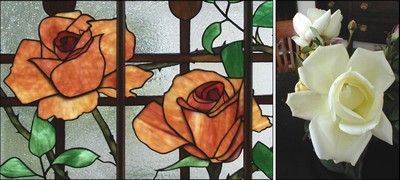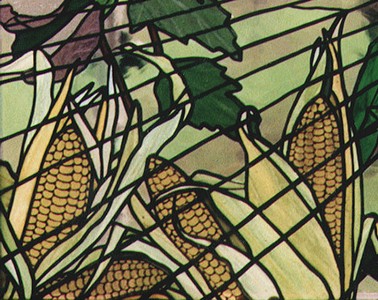Line Relationships: More to Lines than Meets the Eye
| Line Relationships: More to Lines than Meets the Eye |
| Robert Oddy |
Lines in stained glass artwork are important design features. With copper foil and lead came techniques, they are often prominent and black with the light source behind them. Carefully designed and implemented lines can enhance the sense of depth in a picture and have a rather paradoxical nature in our work. I find that I have a rather complicated relationship with my lines.
Real Lines and Lead Lines
 |
| Figure 1: Stained glass roses have outlines, a real rose does not. |
In representational art, lines often seem to get in the way. A blossom made with traditional stained glass techniques has black lines around the edges of each petal. A real blossom does not (Figure 1). Very few things in the real world have black outlines — neither natural nor artificial objects. What we see is not a line with thickness but a transition from one surface with its colors and texture to another with a different appearance behind it or in front of it. If we focus our eyes on an edge in the real world, the transition is sharp or sudden, but there is still no line, even a thin one. If the edge is out of focus, the transition is blurred or more gradual. It is still not a line, even a grey one. We might regard certain things in the real world as lines, such as cables and thin tree branches, but such a line is really a pair of transitions very close together. Sometimes, we perceive lines within the texture of things—the veins of a leaf, the crests of the ripples or waves on the surface of a body of water.
 |
| Figure 2: Oak Tree (2008) Robert Oddy. |
| Some branches are just black lines. |
When I represent natural things in a stained glass window — flowers, trees, animals, people — my instinct is to try to minimize the number and obtrusiveness of the lead lines. Is this a hopeless task? I also sometimes feel tempted to make an image of electric power pylons (which I have never done) or, more often, tree branches in winter (Figure 2) because this gives me the perfect excuse to make black lines!
 |
| Figure 3: (Untitled, 2010), Robert Oddy. |
| Flowers look delicate even with black outlines. |
Perhaps I shouldn’t worry so much. Maybe lines in stained glass are not as significant as we might think. When we look at a window, we have an amazing ability to overlook the black lines. We can see a flower as a delicate object, even though it has black lines around each petal (Figure 3). We can even ignore a reinforcing bar going straight across a large church window. How can we do this?
Noisy Lines
 |
| Figure 4: Friendship (1992) Robert Oddy. |
| Technical lines are highlighted in red. |
The first answer that springs to mind is that we are very tolerant of noise. Noise is that which is within the field of our senses, but is irrelevant to the meaning of the message. The message might be a picture, a song, or the road we are driving along. We filter out parts of the picture that we don’t want or need to see. We are extremely good at this. The world is an incredibly complex place, and we would be utterly confused all the time if we could not ignore the noise. I think this explains why we usually overlook spurious lines in a stained glass panel—lines that the artist inserts for technical reasons to do with such things as cutting the glass or reinforcing the panel. I will call these “technical” lines. This is illustrated in Figure 4, where I have highlighted that panel’s technical lines in red. As we interpret the picture, they have no meaning to us and we filter them out as noise.
Imaginary Outlines
 |
| Figure 5: From Central New York (1989) Robert Oddy. |
| Fine-line detail shows in the corn husks and kernels. |
Another possible answer to the question as to how we can overlook lead lines intrigues me. We don’t pay attention to the explicit outlines in a stained glass panel, because our minds would put them there anyway. We don’t draw much distinction between lines that are really there and lines that we imagine to be there. When our eyes receive light from the real world around us, it is an incredibly complex jumble of patterns in which our minds have to find some sense. For the purely practical purpose of staying alive, we have to interpret all the light patterns as objects in the world around us, which we must either somehow deal with or avoid!
 |
| Figure 6: Liturgical Dancer (2011) Robert Oddy. Drapery |
| glass used for the dress gives fold lines in a natural way. |
Objects must be distinguished from one another. We have to know where one object ends and another begins. In order to do this, our minds “draw” lines around the objects as we identify them. We do this unconsciously. If we study the edge of an object consciously, as an edge, we see that there is no explicit line, but that’s not how we usually look at the world. This notion is consistent with what has been discovered about our visual system.
At an early stage in the process of visual perception, our brains call upon cells that specialize in detecting the transitions, which I mentioned above. Each of these cells receives inputs from a number of rods and cones in the retina, and gets excited when a transition between colors or light values crosses it. Our visual system does not resemble a camera or a computer screen, which can only record or display pixels which are meaningless to them. It has evolved into a specialized system for distinguishing and recognizing objects.
Working with Lines
 |
| Figure 7: From Conquerors (1994) Robert Oddy. |
| Copper foil overlay is used for chain mail. |
What does all this tell us about the use of lines in representational stained glass work? Lead lines that serve as the outlines of objects will be less intrusive in the viewer’s perception than extra technical lines. Technical lines will be dismissed as noise so long as they are not too thick and bold or inelegantly shaped. As a general principle, most lines should be as thin as possible, whether they participate in the outline of an object or are technical lines. Of course, there are other factors. In a large panel with large individual pieces of glass, there may be structural reasons for using wider foil or came. On the other hand, when I say “thin,” that is a relative term. The same width of line will appear thinner in a large panel than in a smaller one, and will look thicker around a small piece than around a larger piece of glass.
We may sometimes wish to make lines appear indistinct in order to add a sense of distance. This can be done by plating a piece of opalescent glass in front of the layer containing the joins, or by painting lines on the reverse side of the glass. I have also found that finishing the solder with black patina makes lines less obtrusive. If there is any front lighting, plain solder will reflect some of it and the line will stand out.
 |
| Figure 8: From Oak Tree (2008) Robert Oddy. |
| Joins were made with carved copper foil for branches. |
Lines that appear to be part of the texture of an object, such as the veins in a leaf, or the ripples on a lake, or the folds in clothing, can be treated more subtly than by joining separate pieces of glass. One approach is to select glass with suitable features, such as streaky glass for leaves (see the corn husks in Figure 5), ripple glass for water, drapery glass for clothing (Figure 6). Another possibility is to paint or engrave the lines, perhaps on the reverse side of the glass. (See the hills in Figure 9 and the faint twigs in Figure 8.) I have sometimes used copper foil overlays for fine detail, such as chain mail (Figure 7), fish scales and corn kernels (Figure 5), that is not readily found in the texture of stained glass.
 |
| Figure 9: Barque (2008) Robert Oddy. |
When the lead line actually represents something, for example a tree branch or the rigging and masts of a sailing ship, we can make the line itself interesting. We don’t want the viewer to ignore this kind of line, so we should make it realistic. A branch varies in thickness, and is usually irregular and knobbly. Figure 8 shows a detail from the lower left of the panel in Figure 2. Some of the branches, those shown with red lines, are just soldered joins. On a sailing ship, the mast usually tapers. These effects can be achieved by applying wide copper foil along the join, and then trimming it with a sharp knife. Very thin lines for a ship’s rigging can be implemented with copper or brass wire, as in Figure 9. A foiled join would be much too wide.
Now let us talk about technical lines, that is extra join lines included for structural reasons. We should design these deliberately and artistically, so that the viewer is less aware of them. We should try to make them harmonious with the design. If a piece of glass surrounding a group of flowers or leaves, has to be divided into two or more pieces, make the join curve like a twig or branch. If a technical line is near an animal or a bird or a vehicle, it could be used to suggest motion. If it is in the sky, it might follow the texture in the glass to be consistent with clouds or wind (Figure 10).
 |
| Figure 10: From Joan’s Garden (2003) Robert Oddy. Joins follow the direction of the swirls in the sky. |
The visual system and human brain are much more complex and subtle than I can describe, and we are capable of interpreting what we see in many ways, depending on our circumstances and purposes. Also, I have limited myself to our perception of lines. So, please do not treat my suggestions as inflexible rules. Artists are playful creatures! We often break the rules to see what happens.
web: www.robertoddy.com | mail: artist@RobertOddy.com | phone: (315) 200-2260
